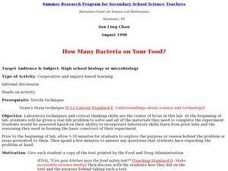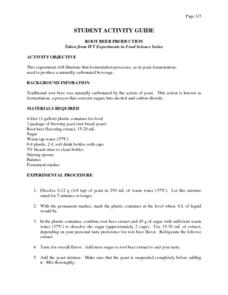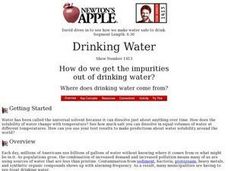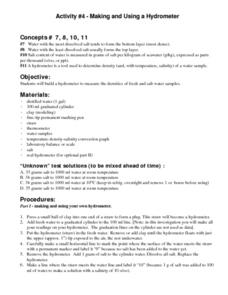Curated OER
What Is A Fossil?
In this fossils worksheet, students read 13 clues pertaining to fossils. Students fit their answers in a crossword puzzle. There is no word bank.
Curated OER
Field Trip to test Water Quality
Students examine water quality indicators,test water quality and record their results. In this water quality lesson students complete a water testing lab and complete a lab report.
Curated OER
How Many Bacteria on Your Food?
Students discuss and conduct a food safety experiment which looks at bacteria and food poisoning. They swab the other area of some food and grow bacteria in an agar plate.
Curated OER
Getting Physical with Estuaries
Students study estuaries and how the physical factors change over time. In this investigative lesson students use a website to gain knowledge of estuaries then in groups they create and present their charts.
Curated OER
Does the Introduction of Pesticides and Fertilizers Alter an Aquatic Ecosystem?
Learners conduct an experiment using a small sample from a local water source. They introduce fertilizers and pesticides, separately, and carefully examine the results in their simulated aquatic ecosystem.
Curated OER
Root Beer Production
In this fermentation worksheet, students conduct an experiment to illustrate how the yeast fermentation process is used to produce carbonation. This worksheet has 5 short answer questions.
Curated OER
Observing Osmosis in a Chicken Egg
Tenth graders develop a hypothesis and explain what they observed on an activity. In this investigative lesson students observe osmosis and report their data using a graph.
Curated OER
Testing Water for Hardness
Students discuss the nature, cause and effect of hard water. Each student conducts a soap test on a sample of hard water where the hardness is known measuring the height of the bubbles produced.
Curated OER
Still Waters
Students construct a still to turn seawater into drinking water. They estimate the cost of distilling it. They investigate ways to make the conversion more efficient. They track the source of their home drinking water and make a map of...
Curated OER
A Funny Taste
Learners participate in a demonstration that illustrates the relative amounts of salt in various bodies of water including the Dead Sea, Sallt Lake, Ocean water and distilled water. They taste and compare various mixtures.
Curated OER
Understanding the pH Cycle within the Aquarium
Students discuss places they have been where the air seemed hard to breathe. They discuss if they could "see" the humidity or smell. Students discuss ways this might relate to the fish in the aquarium. The teacher introduces pH and how...
Curated OER
Lead Extraction
Students investigate one method used in the detection of lead in the soil. They use a Lead Check Soil Kit to safely obtain results in 30 minutes or less in levels of 400 ppm or above. In addition, they write a brief description of what...
Curated OER
Watching Crystals Grow
Pupils observe crystal growth of Epsom salts and the variables that hinder or help their nucleation and growth. They illustrate a series of drawings/pictures as the crystals grow. They look for the different shapes they form as well as...
Curated OER
Embryological Development Using Medaka Fish
Students analyze and record major events that occur in the development of Medaka fish eggs from fertilization to hatching. In small group, students describe the processes involved, creating a timeline of the major events in the...
Curated OER
Condensation and the Water Cycle
Students explore the natural distallation process that occurs in the water cycle. They use plastic cups and cotton swabs to observe the condensation process that is evident in the water cycle.
Curated OER
Slime and Polymers
Young scholars participate in an experiment to demonstrate how mixing certain chemicals together can change the consistency of both chemicals. Glue, water, and borax are used to create a slime-like substance which is examined to...
Curated OER
Osmosis
Learners explore diffusion and active transport. They observe the effects of eggs in vinegar and predict what will happen when eggs are placed in corn syrup with food coloring. Students complete worksheets which lead them to describe...
Curated OER
Making and Using a Hydrometer
Students build a hydrometer to measure the densities of fresh and salt water samples. They record the water temperature and density and use the temperature, density, and salinity conversion graph to locate the salinity. Finally,...
Curated OER
Salinity
Learners define and discuss salinity, conduct classroom experiment to determine salinity of water sample by using hydrometer, record predictions, and demonstrate understanding of how salinity influences object's ability to float in water.
Curated OER
Precipitation, Acids and Bases, and Molarity
In this chemistry learning exercise, students write the net ionic equations for any precipitation reactions that occur on mixing aqueous solutions for each of the substances listed. Then they write the net ionic equations for the...
Curated OER
Sedimentary Rocks- Formation and Types
In this sedimentary rocks resource worksheet, students follow the guide for reading this informational text. They read about the formation of sedimentary rocks, and the three major types of sedimentary rocks.
Curated OER
Somatic Cell Division
In this cell division worksheet, students review the steps involved in a human somatic cell, from interphase to mitosis, to cytokinesis. This worksheet has 21 fill in the blank statements.
Curated OER
Biochemistry Assignment
In this biochemistry worksheet, students complete a table by filling in the missing information about different elements. Students draw the Bohr diagram and the Lewis dot diagram for several atoms.
Curated OER
Chapter 22 - 25 Review
For this chemistry review worksheet, students explore their knowledge of solutions, acid and bases, nuclear reactions, and radioactive decay as they answer 33 matching, fill in the blank, and short answer questions.

























